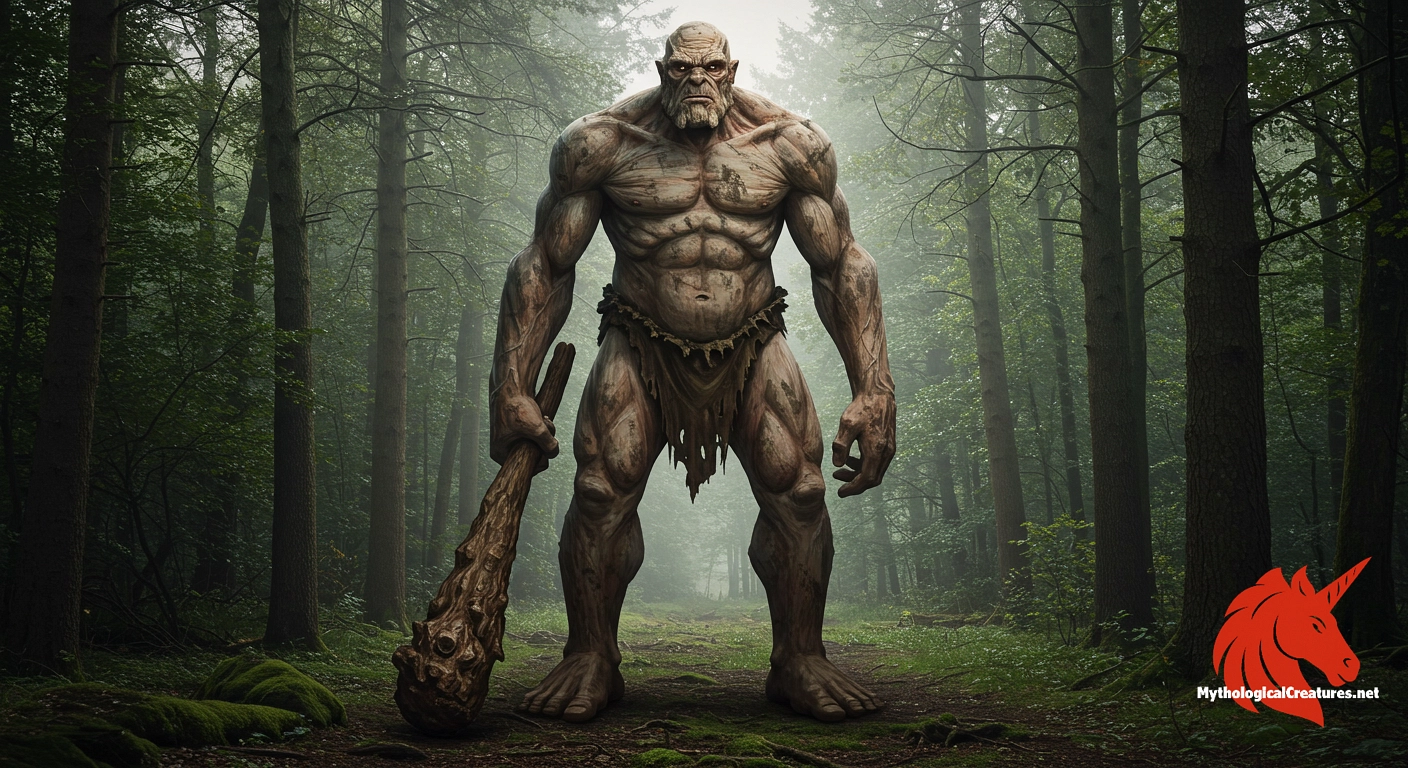Ascapart: Ascapart is a legendary giant from English folklore, renowned for his immense stature and strength.

Ascapart
Ascapart - Ascapart is a significant figure in regional folklore, symbolising themes of betrayal and transformation, and his legend has evolved over time through various adaptations.
Origins & First Encounters
Ascapart emerges from the vibrant tapestry of English folklore as a legendary giant whose exploits capture the imagination. He is known by a myriad of names, including Ascupart, Ascopard, Ascopart, and Asgapard, each variant reflecting the fluidity of medieval oral tradition. His storied past is intertwined with the adventures of Bevis of Hampton, a heroic figure whose deeds are as renowned as the giant’s own epic presence. In these timeless narratives, Ascapart is described as a towering 30-foot figure whose extraordinary size sets him apart from ordinary men and even from other giants. Despite his imposing stature, he is distinguished as the smallest among his kin, a paradox that adds depth to his character. His initial encounter with Bevis is marked by an awe-inspiring display of strength and surprise, as he effortlessly carries the hero, his wife, and even a horse under his arm. Over the course of the legend, his shifting role—from a formidable adversary to an unexpected squire—reveals a complex interplay of power and vulnerability. Elements of betrayal, transformation, and human frailty weave through his tale, cementing his place in the cultural mythology of medieval England. Ancient traditions hint at influences drawn from older Near Eastern and European legends, further enriching his narrative. Ultimately, Ascapart’s enduring legacy captures both the raw power of nature and the intricate human emotions that underlie myth.
Source Texts & Tale Variants
The primary narrative of Ascapart is embedded in the legendary saga of Bevis of Hampton, where early texts and artistic depictions have preserved his myth for centuries. Medieval illustrations, such as those restored in the Southampton Bargate Monument Gallery, serve as a visual testament to his once formidable presence. These depictions, possibly tracing back to the early 14th century, offer a rare glimpse into the way folk traditions celebrated and memorialised his feats. Multiple textual narratives contribute to the layers of his story, each variant enhancing the enigmatic image of the giant. In alternate renditions, his character transforms into a half-man, half-dog figure known as Pelucan, reflecting the dynamic nature of oral legends as they evolve over time. A notably different adaptation in Russian folklore, where his persona is reimagined as the centaur-like Polkan in the tale of Bova Korolevich, further underlines his versatile nature. These divergent sources illustrate how storytelling adapts to cultural contexts, ensuring that the essence of Ascapart endures even as his form changes. The rich tapestry of manuscripts, paintings, and later literary references testifies to the fascination that his myth has inspired. Each source, whether visual or textual, contributes unique details to a collective narrative that spans regions and eras. Altogether, the layered story variants highlight the timeless appeal of a character who continues to provoke the imagination.
Form & Powers
Ascapart is most famously depicted as a colossal figure, standing at an imposing 30 feet tall, a stature that immediately asserts his monumental presence. His build is portrayed with robust, muscular contours typical of legendary giants, suggesting immense physical strength intertwined with an almost mystical otherness. In many accounts, despite being the smallest of his kind, his very form exudes a sense of raw power that captivates both friend and foe alike. One of the most striking elements of his portrayal is the massive club he wields—crafted from an entire tree—which symbolises his deep connection to the natural world and his formidable might. His features, though only sparingly detailed in early accounts, convey a rugged intensity that hints at a life shaped by continual conflict. Later adaptations deepen this portrayal by introducing hints of animalistic features, as seen in versions where he morphs into a half-man, half-dog entity. These evolving depictions add an extra layer of complexity to his character, merging human ingenuity with bestial force. While traditional narratives offer glimpses of a primitive warrior garbed in simple attire, this minimal description is often expanded through local artistic renditions. The amalgamation of these physical traits serves to underscore the duality embedded in his character—a blend of the human and the monstrous. Across all descriptions, Ascapart’s physical presence remains a striking embodiment of the extraordinary within a mythic framework.
Regional Faces
In the locales of Hampshire and the New Forest, Ascapart’s legend is deeply interwoven with the fabric of local history and myth. Here, his tale is celebrated as an essential component of the region’s folkloric heritage, where his dramatic encounters with Bevis of Hampton are recounted with both awe and amusement. Local artistic traditions, notably the paintings preserved at the Southampton Bargate Monument Gallery, vividly capture his image and reinforce his place in the cultural landscape. Regional storytellers have adapted the giant’s narrative to reflect community values, often portraying him as a being who, despite his might, is intricately linked to the vicissitudes of human endeavour. Beyond England, variations of his story continue to evolve; in some adaptations, his character is reshaped into a half-man, half-dog figure, while in the Russian tradition he emerges as a centaur-like creature known as Polkan. These localized transformations underscore how deeply regional identity can influence the retelling of a myth. Storytellers across different cultures infuse their own aesthetic and narrative preferences into the legend, allowing Ascapart to serve as a chameleon of myth. The contours of his narrative vary according to the cultural and geographical contexts, highlighting a universal appeal that adapts to diverse heritage. Through these regional lenses, his legend evolves into a rich mosaic that mirrors the multifaceted nature of folklore. Ultimately, Ascapart is not merely a fixed character but a dynamic symbol reflecting local spirit and historical context.
Cultural Parallels
Ascapart stands alongside other legendary giants in a global tradition that illustrates the universal allure of beings of immense size and ambiguous morality. His multifaceted character, oscillating between fearsome adversary and an almost sympathetic squire, invites comparisons to giants found in Norse, Greek, and even Biblical traditions. Similar to figures such as Goliath or the titanic beings of ancient lore, his narrative encapsulates the tension between overwhelming physical power and the human frailties that lie beneath. The metamorphosis of his character—from a daunting 30-foot giant to a hybrid creature with bestial attributes—mirrors mythic transformations found in various cultures, where the lines between man, beast, and spirit blur. This fluidity in identity echoes themes common to many mythologies, where transformation is both a curse and a form of redemption. The role he plays in the saga of Bevis of Hampton, marked by betrayal and unexpected alliance, finds a resonant parallel in lore that challenges simple binaries of heroism and villainy. The evolving depictions of Ascapart underline a broader pattern in myth where powerful figures are as much a reflection of societal anxieties as they are an embodiment of human aspiration. Cross-cultural adaptations, such as his reinterpretation as Polkan in Russian folktales, further exemplify the universality of his archetype. By drawing comparisons with giants from diverse traditions, it becomes clear that his enduring myth speaks to a shared human fascination with the extraordinary. In many ways, Ascapart’s legend is a microcosm of the broader dialogue between culture, nature, and the forces that shape human destiny.
Legacy & Modern Evolution
Over the centuries, the portrayal of Ascapart has evolved from a straightforward embodiment of colossal might to a richly layered symbol in literary and artistic traditions. His origins in medieval England, as part of the fascinating saga of Bevis of Hampton, captured the imagination of audiences who found in his story both spectacle and allegory. Early visual records, such as the intriguing paintings stored in the Southampton Bargate Monument Gallery, provide compelling evidence of his cultural importance during the medieval period. Over time, changes in societal attitudes and artistic styles brought forth new adaptations, transforming him into a figure with hybrid characteristics, blending human and animal traits. Modern reinterpretations have further expanded his mythical dimensions, as exemplified by the coinage of the adjective "ascapartic" in David Foster Wallace’s Infinite Jest, which highlights his symbolic reach into contemporary literature. These evolutions speak to a broader phenomenon where legendary figures are continually reimagined to reflect the values and artistic expressions of their times. Today, Ascapart’s narrative serves as a touchstone for discussions about the nature of power, betrayal, and transformation in myth. His journey from a fearsome giant to a multifaceted cultural icon mirrors the transformative journey of folklore itself—a dynamic interplay between tradition and modern reinterpretation. The continuing fascination with his character underscores the enduring human need to explore and redefine the boundaries between the natural and the supernatural. In essence, his legacy is a living dialogue between past and present, celebrating the malleability of myth and its capacity to inspire across generations.
Interesting Fact
The adjective 'ascapartic', coined by David Foster Wallace in Infinite Jest, directly references Ascapart, underscoring the giant's remarkable cultural impact.
Quick Creature Info
Origin:
Features:
Our Mythic Legendary Rating:

Also Sometimes Known As:
Habitat:
Supernatural Powers:
Physical Attributes:
Abilities:
Behavior:
Weaknesses:
Lore:
References
Discover Another Mythical Legend You May Not Have Heard Of?
Uncover the mysteries of ancient folklore and expand your knowledge of legendary beings from cultures around the world.
Dare to Meet the Shinma Aungphyu....
Curated by the Mythological Creatures Team (rev. May 2025)
